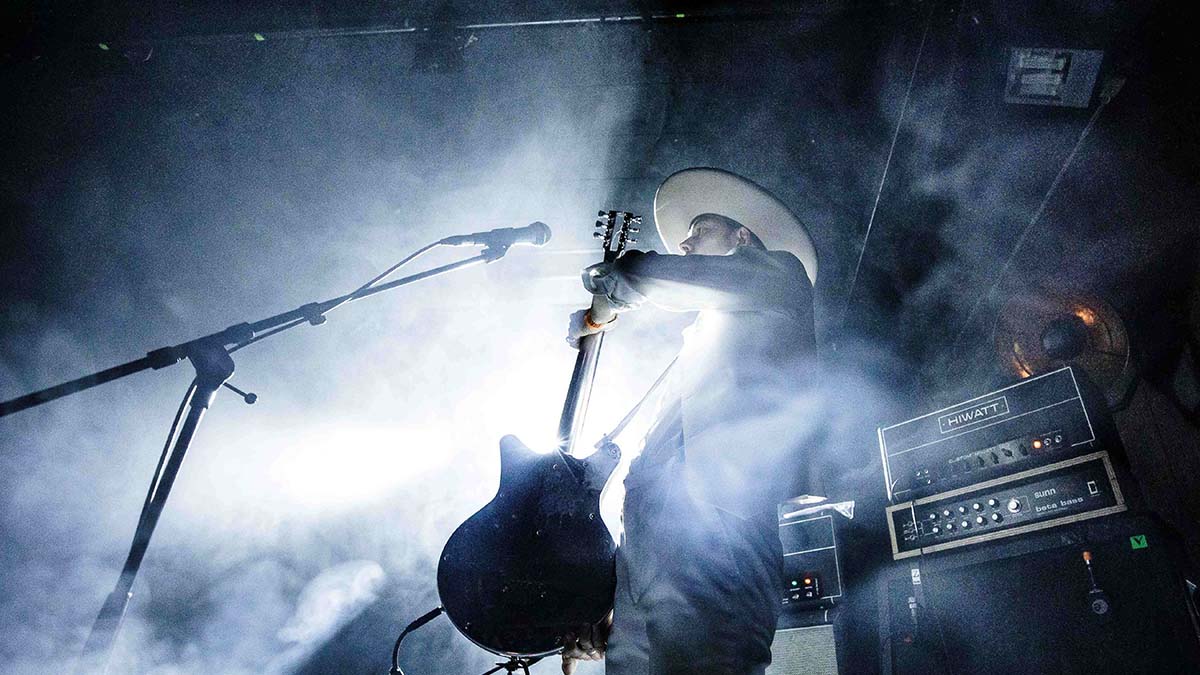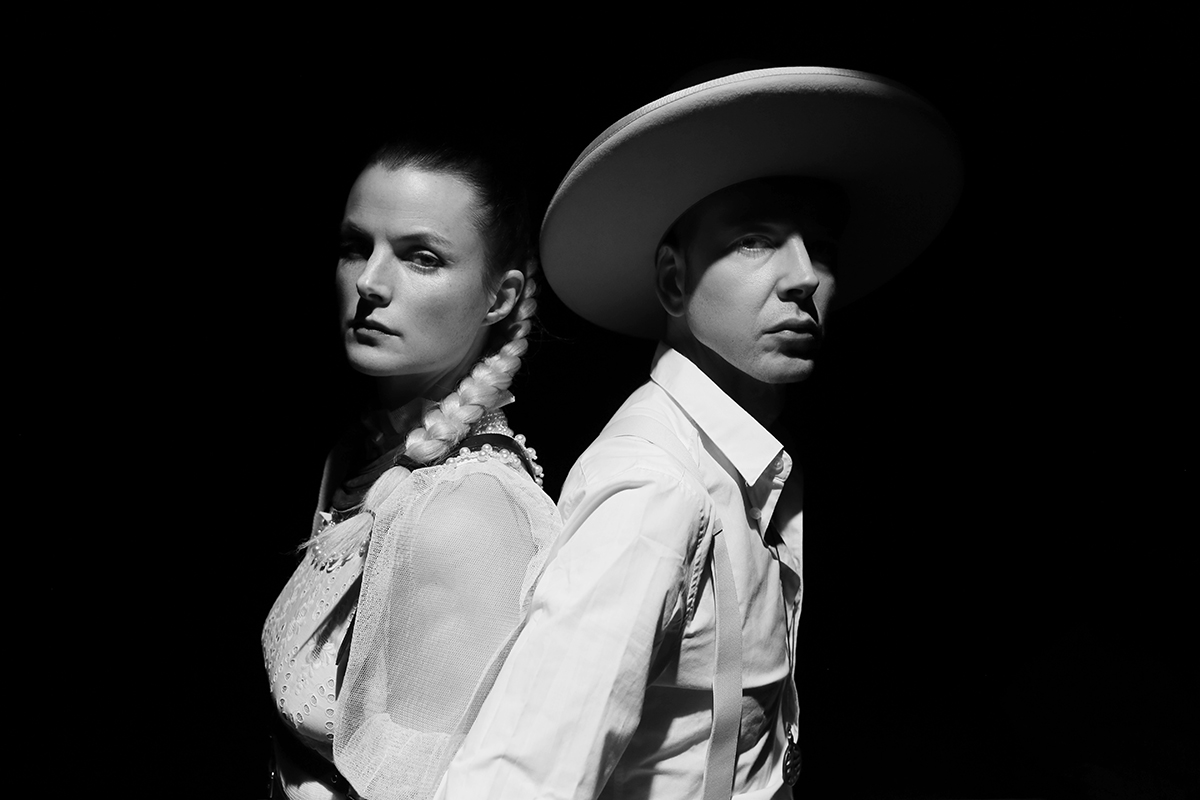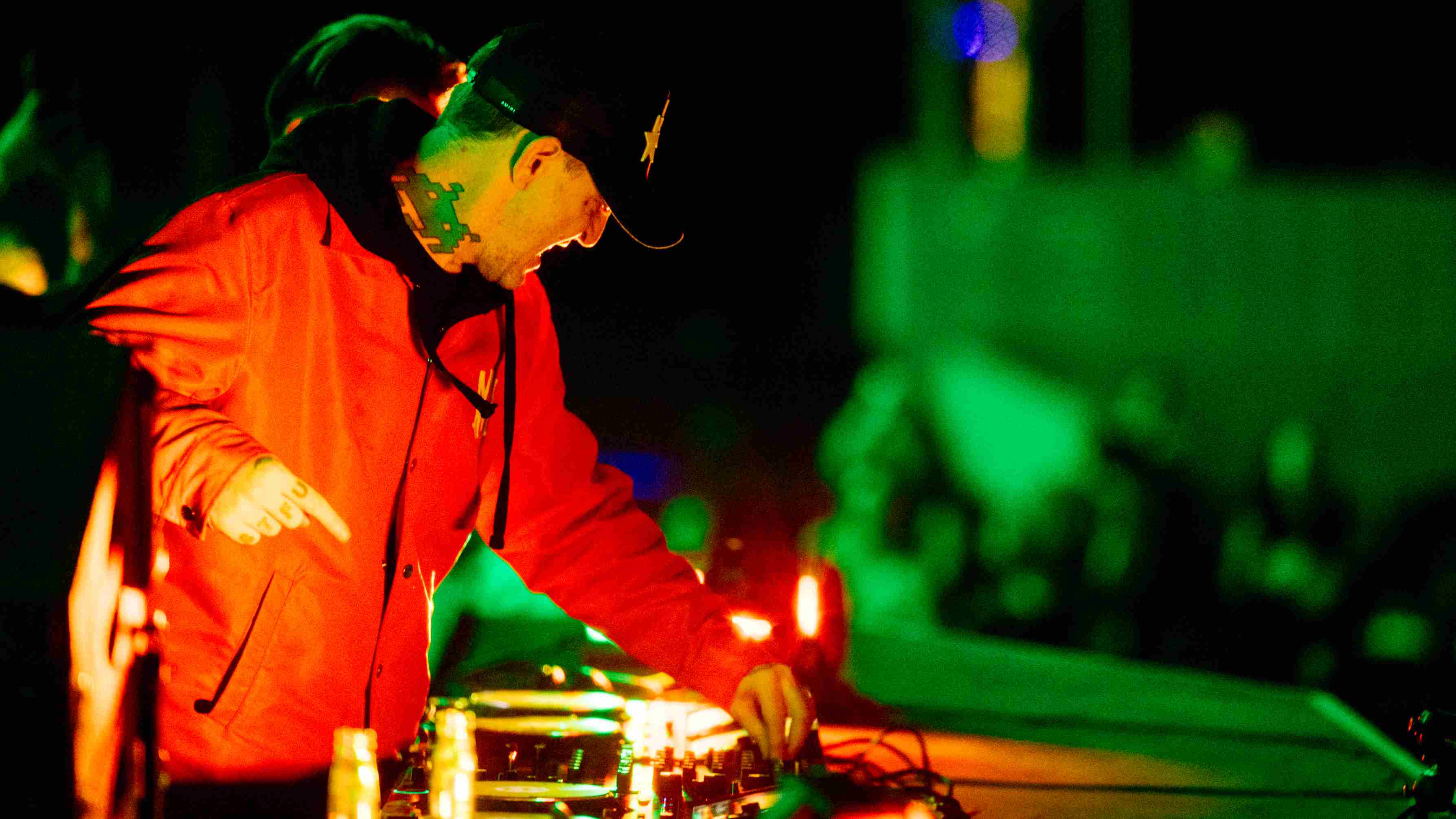Årabrot‘s Kjetil Nernes: “My approach to guitar has developed through the years, but this mix of punk-rock and Glenn Branca minimalism is still the backbone“
The Norwegian noise-rock trailblazer and Hiwatt superfan on Kevin Burkett's aluminium-necked guitars, novelistic writing, and the layered history of rock 'n' roll

We often call Årabrot noise-rock and that's okay as shorthand goes, but it is insufficient for a band who has made a career of colouring between the lines of new wave, punk and metal – a sound with one foot in the avant-garde and the other taking pleasure from long-established rock 'n' roll practices.
Maybe in 2021, we've finally found an adequate descriptor for the Årabrot sound by way of the title to their ninth full-length album, Norwegian Gothic. It feels apt. Norwegian Gothic – to spin the record you'll know exactly why it fits. The sound constructed by guitarist/vocalist Kjetil Nernes and Karin Park on keys and vocals is struck through with a sense of danger and dark romance.
Living together with their kids in an old church in rural Sweden, Nernes and Park have the time and space to bring big ideas to bear on their rock 'n' roll sound. As Nernes explains, the songs have a straightforward rock 'n' roll architecture. And in some respects, he is a man of simple pleasures – of electric guitars custom-built by Kevin Burkett of the Electrical Guitar Company going into large Hiwatt guitar amplifiers.
When I started writing the songs for this album I thought the title was fitting, not only for the music, but also as a description of the kind of music Årabrot is playing
But the atmosphere of morbid romance, and danger, and the inspiration behind his arrangements – often found outside music in literature, film and visual art – lend Nernes' songwriting a sense of the uncanny.
The recording of Norwegian Gothic saw Nernes and Park joined by the likes of Lars Horntveth (Jaga Jazzist), cellist Jo Quail, Tomas Järmyr (Motorpsycho), Anders Møller (Turbonegro, Ulver) and Massimo Pupillo (Zu). Production was handled by Jaime Gomez Arellano. It sounds incredible.
Here, Nernes unpacks his songwriting philosophy, explains how the Norwegian Gothic title came to being, and talks about the gear and production choices behind the new record.
You’ve titled this record Norwegian Gothic and that immediately calls to mind Grant Wood’s American Gothic (which, if it had been commissioned for this record, could working as cover art). What similarities are there between the American Gothic tradition as you see it, and what we might consider as “Norwegian Gothic”?
Get the MusicRadar Newsletter
Want all the hottest music and gear news, reviews, deals, features and more, direct to your inbox? Sign up here.
“Yeah, a friend of ours in Chicago labelled us Norwegian Gothic some years ago – obviously a tongue in cheek reference to the painting – and I wrote it down. When I started writing the songs for this album I thought the title was fitting, not only for the music, but also as a description of the kind of music Årabrot is playing.
“There have been so many questions through the years about what Årabrot really is about so why not coming up with our own genre? Also we are obviously very inspired by the early eighties new wave bands that used to be called gothic, you know Bauhaus, Birthday Party etc.
“The American Southern Gothic literary style is also a huge influence – Faulkner, Cormac McCarthy… It all fits the Norwegian Gothic. The cover art is definitely inspired by the painting. Karin is five months pregnant in that picture.“
Southern Gothic literature feels very much of a piece with its place. Is there a parallel to be drawn between that rural American milieu and rural Scandinavia?
“We live deep in the Scandinavian forests and it reminds me so much of the American Midwest or even parts of the south. There are forests but also vast flat farmlands, and sparsely populated areas with very American style wooden houses. Even the church we live in would fit an American western very well.“
And does that inform the songwriting? Both environments seem fertile ground for artists.
“Very much. The freedom of living far away from everything else and the closeness to nature brings about an ancient notion of something bigger, something deeper. Something that comes from different times. It is great for creativity.“
I easily write riffs and song structures but it never makes any sense until they are part of a bigger idea – songs set in order almost like chapters in a book or a film
I know you have referenced Cormac McCarthy as an inspiration, but is it the case for you that the most important inspiration is simply an idea or mood and then finding the right context for the musical idea so it fits in a grander scheme? Almost thinking novelistically about the music?
“Exactly. I easily write riffs and song structures but it never makes any sense until they are part of a bigger idea – songs set in order almost like chapters in a book or a film – usually based on a textual idea or just a general mood. I think listening to Årabrot makes more sense if you actually sit down and listen properly to the whole album. Listen deep, you know. That is at least the intention. “
Could you talk a little bit about Kevin Burkett’s Electrical Guitar Company. You have a regular and a baritone – were these custom builds? And what is it about the aluminium build that you can’t get from wood?
“Yeah, I even have an EGC bass. They are all custom built by Kevin many years ago. I was looking for something that Fenders and Gibsons couldn’t do. I wanted something with more resistance. I used [Steve] Albini’s Travis Bean on some of the early albums and loved it. He suggested checking out EGC and I bought the three models within a year or so.
“They are killer guitars, very specific and no fuss. I even love the sheer weight of them, the physicality. The baritone version can deal with really low tunings and be very close to a bass without actually being a bass, which suits my playing very well.“
Wood is more blues, aluminium’s more punk, I guess. Or industrial. The old Italian futurists certainly would approve of metal guitars
It’s funny, it might be quite a futuristic idea – an aluminium neck and body – but there is something elemental about the sound, this fundamentally old-school rock ’n’ roll quality. Is that something you recognise, this tension between classical and radical design?
“There’s certainly a rock ’n’ roll quality to them. Wood also has that, but in a different way. Wood is more blues, aluminium’s more punk, I guess. Or industrial. The old Italian futurists certainly would approve of metal guitars. I have always been interested in the extremes, that being loud or quiet, classical or radical, life or death. The in-between, the middle-of-the-road, usually bores me.“
That tension feels evident in Årabrot, too, especially in Norwegian Gothic. Is it a conscious effort on your part, to explicitly recontextualise rock ’n’ roll and present a fresh perspective on it?
“Yes indeed. I often see the history of rock ’n’ roll as in layers. As if certain parts of the fifties were mixed with grunge or metal of the nineties. Or if a Beefheart-rhythm were juxtaposed with a post-punk song. Or if the Residents was a stoner band and so forth. It is all a lovely mixture of impulse. I don’t even have to think much about it really. It comes naturally. I love rock ’n’ roll music.“
I always hear a surrealist streak in your work. Is that something you recognise in your sound? And in an age where politics are getting more radical and extreme and art is getting safer, do you think that surrealism is one movement or approach that cannot be housetrained?
“I don’t think our music is particularly surreal or dada for that matter. What seeps through is the choice to trust your own ideas instead of following the standards. Our songs are pretty much straight forward rock ’n’ roll, but the lyrics are a little different and the band setup – synth bass in a rock band for instance – makes a whole lot of difference.“
It is such a different world and if you didn’t experience the sheer power of pre-internet musical times it is hard to understand.
“But yeah, I agree. The arts, music is getting safer. I mean, when I grew up in the early nineties the raucous and feedback-ridden Nirvana was the biggest band in the world. Nowadays even the underground bands buy followers on Facebook and have pre-recorded guitar feedback when playing live.
“It is such a different world and if you didn’t experience the sheer power of pre-internet musical times it is hard to understand. But that said, I don’t think everything was better before. Quite the contrary actually.“

Do you have a clear idea in your mind of what the album should sound like when you start writing?
“I have a very clear idea. Usually written down in one of my notebooks. Obviously things change a little during the process, but the overall idea usually stays the same.“
Can you talk a little bit about the recording process. The record sounds incredible.
“Norwegian Gothic was very well recorded partly in producer Jaime Gomez Arellano’s Orgone Studios in the UK and partly in our church studio. Definitely going into a DAW but through some amazing and stupidly expensive mics, amps and outboard gear. A perfect mix of digital and analogue I’d say.“
With the new setup – bass synth, mellotron, drums and guitars plus vocals – I need a few new elements to cover up certain sonic areas. So I A/B a bass rig and a guitar rig and use the POG to add a little extra bass to the bass side
The Fulltone OCD is ever present on your pedalboard, but you also have a Plasma pedal, a Superego and a POG. How often would these get used and when you have Karin handling the more electronic elements in your sound, what are you looking for from those pedals? Do they help with the writing?
“The OCD and Hiwatts have been my trusted workhorses ever since the early noughties. I usually experiment with some other amps and pedals when in the studio but always drift back to the Hiwatts for the main sound.
“With the new setup – bass synth, mellotron, drums and guitars plus vocals – I need a few new elements to cover up certain sonic areas. So I A/B a bass rig and a guitar rig and use the POG to add a little extra bass to the bass side. For some of the new songs we need a little more dirty fuzz and I have been using the Plasma and the Hudson Broadcast for just that. Both killer pedals.
“The Superego is such fun and can do a lot of cool things. I use it very simply though, just adding a little colour for certain parts. Like a synthy reverb. I never use pedals for writing the songs, it is usually done on an acoustic guitar or an organ. Or in my head while taking a walk.“
Your rig seems very practical. It's a setup that’s not too dissimilar to what, say, Pete Townshend might have used, with big Hiwatt amps, a drive pedal in front for a little extra oomph and a guitar. Does having a minimalist approach to gear free you up to explore different aspects of your sound?
“Spot on. The Hiwatts are very clear and loud and to the point and it creates a lot of room for other instrumentation. I am really focussed on filling out the whole spectrum of sound when playing live and making records, and it is important to not make a mess sonically. Also a minimalist approach helps when singing while playing.“
Related to that, much of the heavy lifting is making sure your mix sounds so big is ensuring that each of the instruments has space to breathe. Is that one of the challenges of your sound, leaving the space for all those dynamics?
“Yes, indeed. There’s a lot going on and the trick is being able to strip down rather than adding more. A lot of it comes down to our producer. Gomez did a phenomenal job with recording and mixing the record.“
The sheer weight and depth you’ve got in the mix is incredible. Can you talk a little bit about how you get such a good low-end tone on tracks such as Hounds of Heaven?
“Back to our eminent producer Gomez. He really did outstanding work with this record. A lot of it comes down to showing great attention to detail and making the initial recordings as good as possible.
“Gomez is incredibly picky with the tuning of the drums and the guitars and also with what microphones to use. We changed drum kits and amps according to what fit the song best. Obviously a killer bass player also helps.“
And finally, we should ask you who have been the most important guitar players for you and why?
“Good and important question! When starting out I was really inspired by Kurt Cobain, then Page Hamilton and finally Buzz Osborne. I used to study those guys meticulously as a teenager. My approach to guitar has developed some through the years, but this mix of punk-rock and Glenn Branca-minimalism is still the backbone of my playing.“
- Årabrot's Norwegian Gothic is out now via Pelagic Records.
Jonathan Horsley has been writing about guitars and guitar culture since 2005, playing them since 1990, and regularly contributes to MusicRadar, Total Guitar and Guitar World. He uses Jazz III nylon picks, 10s during the week, 9s at the weekend, and shamefully still struggles with rhythm figure one of Van Halen’s Panama.
“A purpose-built solution for bassists seeking unparalleled sound-shaping capabilities”: Darkglass Electronics unveils the Anagram Bass Workstation – a state-of-the-art multi-effects for bass guitar with neural amp model support and a 7” touchscreen
GAK is gone: UK music store giant GAK just got bought by Gear4music for £2.4 million










